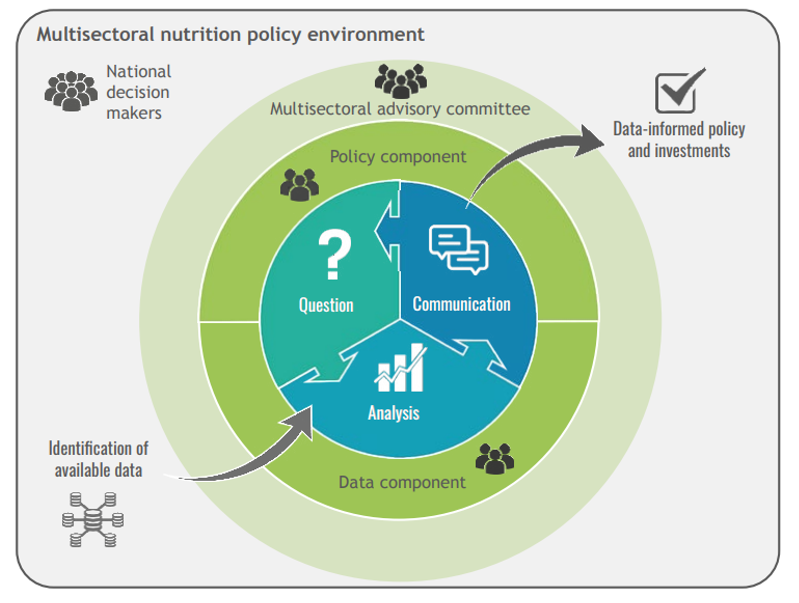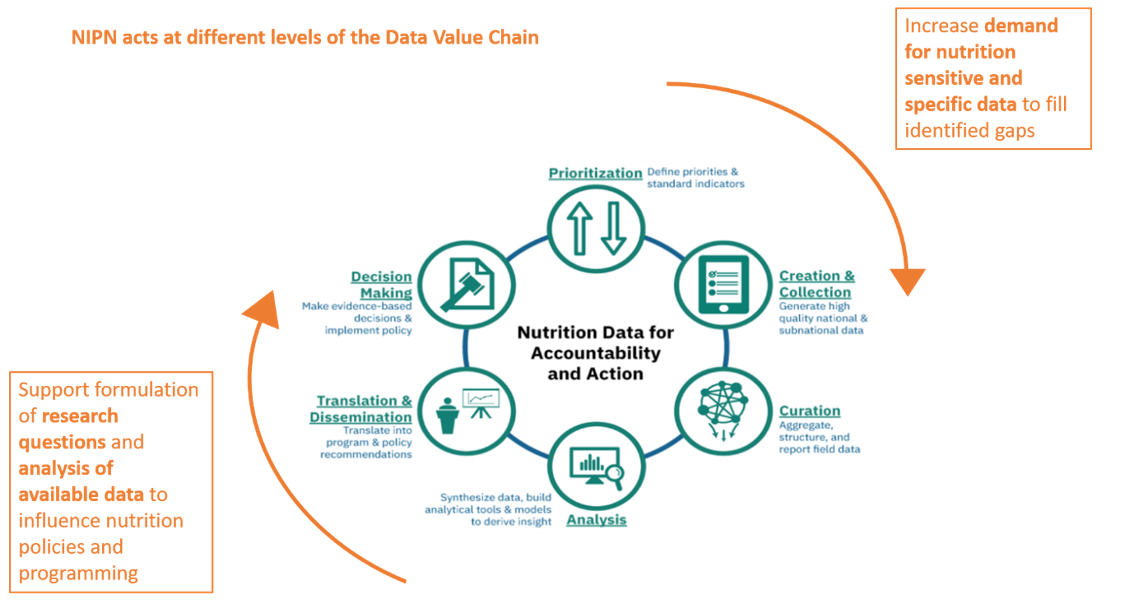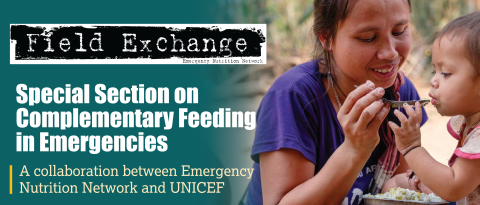National Information Platform for Nutrition: An overview
Barbara Baille is a Nutrition Advisor at Capacity for Nutrition-National Information Platforms for Nutrition (C4N-NIPN) Global Coordination team, a component implemented by the GIZ and based in Brussels, Belgium.
What is NIPN?
The National Information Platforms for Nutrition (NIPN) initiative was launched by the European Union in 2015 with the goal of supporting partner countries who are part of the global Scaling Up Nutrition movement. These countries have committed to delivering evidence-based programmes and interventions to improve human nutrition in their progress towards the 2030 Agenda for Sustainable Development Goal number 2 – to “end hunger, achieve food security and improved nutrition and promote sustainable agriculture”. Responding to the need to maximise the use of existing data while also creating the demand to fill data gaps, the main objective of the NIPN initiative is to create country-led and country-owned information platforms for nutrition to strengthen national capacities in the analysis of nutrition information and data, in order to better inform policymakers in the areas of policy, programme and investment for nutrition.
The first phase of the initiative was implemented in nine countries: Bangladesh, Burkina Faso, Ivory Coast, Ethiopia, Guatemala, Kenya, Lao PDR, Niger, and Uganda. To support each country’s implementation and to coordinate technical assistance and capacity building, a Global Support Facility was established in 2015. As of 2020, the Global Coordination Facility has been managed by Capacity for Nutrition (C4N), a joint action financed by the EU and the German Federal Ministry for Economic Cooperation and Development and implemented by Deutsche Gesellschaft für Internationale Zusammenarbeit (GIZ).
NIPN partners work under one common results framework that focuses on: strengthening technical ability to provide relevant nutrition information and analysis, enhancing the demand by policy makers for NIPN outputs, and strengthening the national ownership of NIPN.
Between 2021 and 2022, all NIPN platforms – except for Bangladesh, where the project closed in early 2022 due to other government priorities – have gradually entered the second funding cycle of the initiative, NIPN Phase II. In this new phase, GIZ delivers technical and programme management assistance for the implementation of the platforms in Ethiopia and Niger. In Burkina Faso, Ivory Coast, Kenya, Lao PDR, and Uganda, UNICEF provides the technical and programme management assistance. In Guatemala, the Centro Agronómico Tropical de Investigación y Enseñanza delivers technical and programme management assistance.
How does NIPN work?
NIPNs are embedded in national host institutions and work closely with national multi-sector coordination systems for nutrition. In each country, a core NIPN team comprises two components – policy and data – that are jointly responsible for implementing the NIPN operational cycle (Figure 1). For the policy component, host institutions convene and facilitate a multi-sector advisory committee, lead policy-relevant question formulation based on government priorities and, in coordination with relevant local partners (researchers, technical and financial partners etc.), interpret data analysis and ensure the strategic communication of actionable recommendations based on the findings.
Figure 1: NIPN operational cycle

For the data component, host institutions collate multi-sector data in a central repository and analyse the data to answer policy-relevant questions. As such, NIPNs are highly complex, dynamic, multi-layered collaborations. The core team must also collaborate with sectoral government ministries and other partners in the nutrition coordination system to: a) identify priority nutrition policy questions through workshops where all relevant partners are invited, b) gather the existing data needed for evidence on nutrition and c) clearly present the evidence and formulate strong recommendations to maximise the chances of uptake. The collaboration between the mandated NIPN host institutions is formalised in a contract or memorandum of understanding, linked to a funding agreement with development partners.
How can NIPN contribute to positive change in the nutrition data environment?
NIPN acts at different levels of the Data Value Chain for Nutrition (Figure 2). The support provided to the research questions formulation process by the core NIPN teams in countries, using available data in each country, strengthens stakeholders’ capacity to analyse and disseminate information. It also allows for the identification of nutrition (sensitive and specific) data gaps, advocating for action to fill these gaps. Of these gaps, nutrition specific and nutrition sensitive programme coverage as well as accessibility to real-time data are some of the most common issues in countries.
Figure 2: NIPN around the Data Value Chain for Nutrition

Since its inception, NIPN has contributed to key results that have played a role in improving the nutrition data environment in several countries, such as the creation of national data repositories for nutrition (Ethiopia, Burkina Faso, Niger) which allow for maximising the use of existing data and findings. NIPN has also contributed to increased collaboration and synergies between sectors that are sensitive to nutrition (Box 1)1.
|
Box 1: Case study - NIPN in Ethiopia The Ethiopia case study pointed out several benefits that can be attributed to the inclusion of NIPN in a high level multi-sector committee such as the Monitoring, Evaluation and Research Steering Committee (MER-SC) of Ethiopia. As the MER-SC is a formal multi-sector committee, attended by sensitive sectors to nutrition, with roles and responsibilities in support of the overall coordination and implementation of national nutrition and food security strategies and programmes, NIPN’s products and outputs receive increased visibility, are discussed with different sectors, and can more easily inform and potentially influence and make specific policy recommendations. Likewise, the MER-SC can guide and influence the work of NIPN in line with its needs and objectives. NIPN products and tools can thus be more specifically designed to meet national nutrition plan needs. The case study also points to the limitation that, although the MER-SC includes most relevant ministries in Ethiopia, several of these do not actively participate or attend meetings. More high-level advocacy may be required to reverse this trend which could be supported by NIPN. |
The initiative has also led the assessment of information systems for nutrition and the mapping of nutrition data in countries to support the identification of data gaps (Burkina Faso, Lao PDR, Niger, Ivory Coast, Ethiopia, Kenya) and investigations into the factors that influence policymaking for nutrition (Bangladesh, Niger, Uganda, Guatemala). The NIPN platforms can also serve to monitor national multi-sector plans for nutrition.
Lessons learned so far
Since its launch in 2015, the NIPN initiative has gathered key lessons which were synthetised in the mid-term review exercise published in 2018 (European Union, 2021). A key message that was identified was that a functional NIPN requires a mature nutrition coordination mechanism that has defined what is expected from the NIPN and how the NIPN will be embedded in existing structures whose mandates align with NIPN functions. Also, multi-sector collaboration platforms are more likely to succeed when three sets of conditions (aligned institutional mandates, logics and capabilities; effective leadership and functional capacities; and trust and credibility) point in the same positive direction. Guatemala, Niger and Lao PDR are good examples of this successful condition: country context and institutional logics were considered from the design phase of the project which resulted in high-level political support, contributing to the progress and success of the platform in the early implementation phase.
The mid-term review also found that investment in strengthening leadership skills and the strategic capacity of a core team in the first months of implementation will help to avoid early setbacks in any multi-sector collaboration.
According to the investigating team: “in countries where lead(s) promoted commitment to improving nutrition outcomes and created a shared understanding of the NIPN objectives, the platform teams had more clarity about their respective roles and responsibilities. In countries where lead(s) were able to motivate host institutions and partners to collaborate, good teamwork was observed, and actions were put in place to build credibility more rapidly. Where platform lead(s) identified windows of opportunity and developed strategies for bringing key stakeholders on board, it was easier to kick-start the evidence-informed policy dialogue. In countries where platform lead(s) had the capability to organise, plan and track progress, timely implementation of the operational cycle and delivery of concrete outputs was observed. When the platform lead could demonstrate transparency in his or her actions, there was a positive impact across the collaborations”.
Multi-sector platforms should also be flexible and adaptive, learn by doing and make iterative adjustments to how the platform is operating. Finally, proactive and continuous risk management must address conditions such as strengthening leadership skills and strategic capacity to ensure the success of the platforms.
Next Steps: The sustainability of NIPN
2022 marks a new chapter of implementation for the NIPN platforms, with its transition into Phase II. An official launch with partners and donors is planned for October 2022 with the focus on the major upcoming challenge for NIPN: accelerating results to achieve the sustainability of the platforms. The road to sustainability is long and requires many steps; NIPN partners and stakeholders have already been solicited to reflect on key questions: How can we ensure that NIPN’s core features (multi-sectorality, regular dialogues, nutrition research question prioritisation, evidence-based decision-making) will last beyond the NIPN donor funding cycle? How can we promote the added value of NIPN among the nutrition community and support the achievement of positive nutrition outcomes in the long term? In the coming years, efforts will be made on the institutionalisation of the NIPN platforms which entails the internalisation of NIPN processes and human resources’ capacities into national institutions’ planning and budgeting. Some platforms (Niger) have already elaborated sustainability studies and plans (NIPN, 2021) that can serve as a blueprint to the achievement of this long-term goal.
For more information, please contact Barbara Baille at barbara.baille@giz.de
References
European Union (2021) Designing effective multisectoral nutrition collaboration: Insights and lessons learned from NIPN. https://www.nipn-nutrition-platforms.org/IMG/pdf/nipn_lessons_learnt_-_en_-_web.pdf
NIPN (2021) NIPN sustainability study report. https://www.nipn-nutrition-platforms.org/Niger-sustainability-study-report


